Apple silicon
Apple Inc. has developed a range of "System on Chip" (SoC) as well as "System in Package" (SiP) processors for powering their mobile consumer devices and other tasks. To meet the stringent power and space constraints common to mobile devices, these chips combine a central processing unit (CPU) with other components into a single compact physical package. Johny Srouji is the executive in charge of Apple's silicon design.[1]
Early series
Prior to the introduction of the Apple "A" series of SoCs, Apple used several SoCs in early revisions of the iPhone and iPod touch. They were specified by Apple and manufactured by Samsung. They integrate a single ARM-based processing core (CPU), a graphics processing unit (GPU), and other electronics necessary to provide mobile computing functions within a single physical package.
The APL0098 (also 8900B[2] or S5L8900) is a package on package (PoP) system on a chip (SoC) that was introduced on June 29, 2007 at the launch of the original iPhone. It includes a 412 MHz single-core ARM11 CPU and a PowerVR MBX Lite GPU. It was manufactured by Samsung on a 90 nm process.[3] The first generation iPod touch also used it.[4]
The APL0278[5] (also S5L8720) is a package on package (PoP) system on a chip (SoC) that was introduced on September 9, 2008 at the launch of the second generation iPod touch. It includes a 533 MHz single-core ARM11 CPU and a PowerVR MBX Lite GPU. It was manufactured by Samsung on a 65 nm process.[3][4]
The APL0298 (also S5L8920) is a package on package (PoP) system on a chip (SoC) that was introduced on June 8, 2009 at the launch of the iPhone 3GS. It includes a 600 MHz single-core Cortex-A8 CPU and a PowerVR SGX535 GPU. It was manufactured by Samsung on a 65 nm process.[6]
The APL2298 (also S5L8922) is a 45 nm die shrunk version of the iPhone 3GS SoC[3] and was introduced on September 9, 2009 at the launch of the third generation iPod touch.
A series
| Evolution of Apple "A" series | ||||||||||||||||||||||||||||||||||||||||||||||||||||||||||||||||||||||||||||||||||||||||||||||||||||||||||||||||||||||||||||||||||||||||||||||||||||||||||||||||||||||||||||||||||||||||||||||||||||||||||||||||||||||||||||||||||||||||||||||||||||||||||||||||||||||||||||||||||||||||||||||||||||||||||||||||||||
|---|---|---|---|---|---|---|---|---|---|---|---|---|---|---|---|---|---|---|---|---|---|---|---|---|---|---|---|---|---|---|---|---|---|---|---|---|---|---|---|---|---|---|---|---|---|---|---|---|---|---|---|---|---|---|---|---|---|---|---|---|---|---|---|---|---|---|---|---|---|---|---|---|---|---|---|---|---|---|---|---|---|---|---|---|---|---|---|---|---|---|---|---|---|---|---|---|---|---|---|---|---|---|---|---|---|---|---|---|---|---|---|---|---|---|---|---|---|---|---|---|---|---|---|---|---|---|---|---|---|---|---|---|---|---|---|---|---|---|---|---|---|---|---|---|---|---|---|---|---|---|---|---|---|---|---|---|---|---|---|---|---|---|---|---|---|---|---|---|---|---|---|---|---|---|---|---|---|---|---|---|---|---|---|---|---|---|---|---|---|---|---|---|---|---|---|---|---|---|---|---|---|---|---|---|---|---|---|---|---|---|---|---|---|---|---|---|---|---|---|---|---|---|---|---|---|---|---|---|---|---|---|---|---|---|---|---|---|---|---|---|---|---|---|---|---|---|---|---|---|---|---|---|---|---|---|---|---|---|---|---|---|---|---|---|---|---|---|---|---|---|---|---|---|---|---|---|---|---|---|---|---|---|---|---|---|---|---|---|---|---|---|---|---|---|---|---|---|---|---|---|---|---|---|---|---|---|---|---|
| ||||||||||||||||||||||||||||||||||||||||||||||||||||||||||||||||||||||||||||||||||||||||||||||||||||||||||||||||||||||||||||||||||||||||||||||||||||||||||||||||||||||||||||||||||||||||||||||||||||||||||||||||||||||||||||||||||||||||||||||||||||||||||||||||||||||||||||||||||||||||||||||||||||||||||||||||||||
| Notes:
| ||||||||||||||||||||||||||||||||||||||||||||||||||||||||||||||||||||||||||||||||||||||||||||||||||||||||||||||||||||||||||||||||||||||||||||||||||||||||||||||||||||||||||||||||||||||||||||||||||||||||||||||||||||||||||||||||||||||||||||||||||||||||||||||||||||||||||||||||||||||||||||||||||||||||||||||||||||
The Apple "A" series is a family of "Systems on Chip" (SoC) used in multiple devices, including some of Apple's portable devices such as certain models of the iPhone, iPad, iPod touch, and the Apple TV digital media player. They integrate one or more ARM-based processing cores (CPU), a graphics processing unit (GPU), cache memory and other electronics necessary to provide mobile computing functions within a single physical package. They are designed by Apple, and manufactured by Samsung and TSMC.
Apple A4
The Apple A4 is a package on package (PoP) system on a chip (SoC) designed by Apple Inc. and manufactured by Samsung.[7] It combines an ARM Cortex-A8 CPU with a PowerVR GPU, and emphasizes power efficiency.[8] The chip commercially debuted with the release of Apple's iPad tablet;[9] followed shortly by the iPhone 4 smartphone,[10] the 4th generation iPod touch and the 2nd generation Apple TV. It was superseded in the iPad 2, released the following year, by the Apple A5 processor.
Apple A4 is based on the ARM processor architecture.[11] The first version released ran at 1 GHz for the iPad[12] and contains an ARM Cortex-A8 CPU core paired with a PowerVR SGX 535 graphics processor (GPU)[9][13][14] built on Samsung's 45-nanometer (nm) silicon chip fabrication process.[3][15] The clock speed for the units used in the iPhone 4 and the iPod touch (4th generation) is 800 MHz. The clock speed for the unit used in the Apple TV has not been revealed.
The Cortex-A8 core used in the A4 is thought to use performance enhancements developed by chip designer Intrinsity, which was subsequently acquired by Apple,[16] in collaboration with Samsung.[17] The resulting core, dubbed "Hummingbird", is able to run at far higher clock rates than other implementations while remaining fully compatible with the Cortex-A8 design provided by ARM.[18] Other performance improvements include additional L2 cache. The same Cortex-A8 CPU core used in the A4 is also used in Samsung's S5PC110A01 SoC.[19][20] The SGX535 in the A4 could theoretically push 35 million polygons per second and 500 million pixels per second, although real world performance may be considerably less.[21]
The A4 processor package does not contain RAM, but supports PoP installation. Hence, there is a package with two low-power 128 MB DDR SDRAM chips (totaling 256 MB) mounted on top of the A4 used in the first-generation iPad, the fourth-generation iPod touch,[22] and the second-generation Apple TV.[23] The iPhone 4 has two 256 MB packages for a total of 512 MB.[24][25][26] The RAM is connected to the processor using ARM's 64-bit-wide AMBA 3 AXI bus. To support the iPad's demand for high graphics bandwidth, the width of the RAM data bus is double that used in previous ARM11 and ARM9 based Apple devices.[27]
Apple A5
The Apple A5 is a system on a chip (SoC) designed by Apple Inc. and manufactured by Samsung[28] that replaced the A4. The chip commercially debuted with the release of Apple's iPad 2 tablet in March 2011,[29] followed by its release in the iPhone 4S smartphone later that year. Apple claims that compared with its predecessor, the A4, the A5 CPU "can do twice the work" and the GPU has "up to nine times the graphics performance".[30]
The A5 contains a dual-core ARM Cortex-A9 CPU[31] with ARM's advanced SIMD extension, marketed as NEON, and a dual core PowerVR SGX543MP2 GPU. This GPU can push between 70 and 80 million polygons/second and has a pixel fill rate of 2 billion pixels/second. Apple lists the A5 to be clocked at 1 GHz on the iPad 2's technical specifications page,[32] though it can dynamically adjust its frequency to save battery life.[31][33] The clock speed of the unit used in the iPhone 4S is 800 MHz. Like the A4, the A5 process size is 45 nm.[34]
An updated 32 nm version of the A5 processor was used in the third generation Apple TV, the iPod touch (5th generation), the iPad Mini, and the new version of iPad 2 (version iPad2,4).[35] The chip in the Apple TV has one core locked.[36][37] The markings of the square package indicates that it is named APL2498, and in software, the chip is called S5L8942. The 32 nm variant of the A5 provides around 15% better battery life during web browsing, 30% better when playing 3D games and approximately 20% better battery life during video playback.[38]
In March 2013, Apple released an updated version of the third generation Apple TV (AppleTV3,2) containing a smaller, single-core version of the A5 processor. Unlike the other A5 variants, this version of the A5 is not a package-on-package (PoP), having no stacked RAM. The chip is very small, just 6.1×6.2 mm, but as the decrease in size is not due to a decrease in feature size (it is still on a 32 nm fabrication process), this indicates that this A5 revision is of a new design.[39] Markings tell that it is named APL7498, and in software, the chip is called S5L8947.[40][41]
Apple A5X
The Apple A5X is a system-on-a-chip (SoC) designed by Apple Inc. that was announced on March 7, 2012, at the launch of the third generation iPad. It is a high performance variant of the Apple A5; Apple claims it has twice the graphics performance of the A5.[42] It was superseded in the fourth generation iPad by the Apple A6X processor.
This SoC has a quad-core graphics unit (PowerVR SGX543MP4) instead of the previous dual-core as well as a quad-channel memory controller that provides a memory bandwidth of 12.8 GB/s, roughly three times more than in the A5. The added graphics cores and extra memory channels add up to a very large die size of 165 mm²,[43] for example twice the size of Nvidia Tegra 3.[44] This is mainly due to the large PowerVR SGX543MP4 GPU. The clock frequency of the dual ARM Cortex-A9 cores have been shown to operate at the same 1 GHz frequency as in A5.[45] The RAM in A5X is separate from the main CPU package.[46]
Apple A6
The Apple A6 is a package on package (PoP) system on a chip (SoC) designed by Apple that was introduced on September 12, 2012, at the launch of the iPhone 5, then a year later was inherited by its minor successor the iPhone 5C. Apple states that it is up to twice as fast and has up to twice the graphics power compared to its predecessor the Apple A5.[47] It is 22% smaller and draws less power than the 45 nm A5.[48]
The A6 is said to use a 1.3 GHz[49] custom[50] Apple-designed ARMv7 based dual-core CPU, called Swift,[51] rather than a licensed CPU from ARM like in previous designs, and an integrated 266 MHz triple-core PowerVR SGX 543MP3[52] graphics processing unit (GPU). The Swift core in the A6 uses a new tweaked instruction set, ARMv7s, featuring some elements of the ARM Cortex-A15 such as support for the Advanced SIMD v2, and VFPv4.[50] The A6 is manufactured by Samsung on a high-κ metal gate (HKMG) 32 nm process.[53]
Apple A6X
Apple A6X is a system-on-a-chip (SoC) designed by Apple Inc., introduced at the launch of the fourth generation iPad on October 23, 2012. It is a high performance variant of the Apple A6. Apple claims the A6X has twice the CPU performance and up to twice the graphics performance of its predecessor, the Apple A5X.[54]
Like the A6, this SoC continues to use the dual-core Swift CPU, but it has a new quad core GPU, quad channel memory and slightly higher 1.4 GHz CPU clock rate.[55] It uses an integrated quad-core PowerVR SGX 554MP4 graphics processing unit (GPU) running at 300 MHz and a quad-channel memory subsystem.[55][56] Compared to the A6 the A6X is 30% larger, but it continues to be manufactured by Samsung on a high-κ metal gate (HKMG) 32 nm process.[56]
Apple A7
The Apple A7 is a package on package (PoP) 64-bit system-on-a-chip (SoC) designed by Apple. Its first appearance was in the iPhone 5S, which was introduced on September 10, 2013. The chip would also be used in the iPad Air, iPad Mini 2 and iPad Mini 3. Apple states that it is up to twice as fast and has up to twice the graphics power compared to its predecessor the Apple A6.[57]
The A7 features an Apple-designed 1.3[58]–1.4[59] GHz 64-bit[60] ARMv8-A[61][62] dual-core CPU,[58] called Cyclone,[61] and an integrated PowerVR G6430 GPU in a four cluster configuration.[63] The ARMv8-A architecture doubles the number of registers of the A7 compared to the A6.[64] It now has 31 general purpose registers that are each 64-bits wide and 32 floating-point/NEON registers that are each 128-bits wide.[60] The A7 is manufactured by Samsung on a high-κ metal gate (HKMG) 28 nm process[65] and the chip includes over 1 billion transistors on a die 102 mm2 in size.[58]
Apple A8
The Apple A8 is a package on package (PoP) 64-bit system-on-a-chip (SoC) designed by Apple and manufactured by TSMC. Its first appearance was in the iPhone 6 and iPhone 6 Plus, which were introduced on September 9, 2014.[66] A year later it would drive the iPad Mini 4. Apple states that it has 25% more CPU performance and 50% more graphics performance while drawing only 50% of the power compared to its predecessor, the Apple A7.[67] On February 9, 2018 Apple released the HomePod, which is powered by an Apple A8 with 1 GB of RAM.[68]
The A8 features an Apple-designed 1.4[69] GHz 64-bit[70] ARMv8-A[70] dual-core CPU, and an integrated PowerVR GX6450 GPU in a four cluster configuration.[69] The A8 is manufactured on a 20 nm process[71] by TSMC,[72] which replaced Samsung as the manufacturer of Apple's mobile device processors. It contains 2 billion transistors. Despite that being double the number of transistors compared to the A7, its physical size has been reduced by 13% to 89 mm2 (consistent with a shrink only, not known to be a new microarchitecture).[73]
Apple A8X
The Apple A8X is a 64-bit system on a chip (SoC) designed by Apple, introduced at the launch of the iPad Air 2 on October 16, 2014.[74] It is a high performance variant of the Apple A8. Apple states that it has 40% more CPU performance and 2.5 times the graphics performance of its predecessor, the Apple A7.[74][75]
Unlike the A8, this SoC uses a triple-core CPU, a new octa-core GPU, dual channel memory and slightly higher 1.5 GHz CPU clock rate.[76] It uses an integrated octa-core PowerVR GXA6850 graphics processing unit (GPU) running at 450 MHz and a dual-channel memory subsystem.[76] It is manufactured by TSMC on their 20 nm fabrication process, and consists of 3 billion transistors.
Apple A9
The Apple A9 is a 64-bit ARM based system on a chip (SoC) designed by Apple Inc. It first appeared in the iPhone 6S and 6S Plus, which were introduced on September 9, 2015.[77] Apple states that it has 70% more CPU performance and 90% more graphics performance compared to its predecessor, the Apple A8.[77] It is dual sourced, a first for an Apple SoC; it is manufactured by Samsung on their 14 nm FinFET LPE process and by TSMC on their 16 nm FinFET process. It was subsequently included in the iPhone SE, and the iPad (2017).
Apple A9X
The Apple A9X is a 64-bit system on a chip (SoC) designed by Apple Inc. It was announced on September 9, 2015, and released on November 11, 2015, and first appeared in the iPad Pro.[78] It offers 80% more CPU performance and two times the GPU performance of its predecessor, the Apple A8X. It is manufactured by TSMC using a 16 nm FinFET process.[79]
Apple A10 Fusion
The Apple A10 Fusion is a 64-bit ARM based system on a chip (SoC) designed by Apple Inc. It first appeared in the iPhone 7 and 7 Plus, which were introduced on September 7, 2016.[80] The A10 is also featured in the iPad (2018). It has a new quad core design with two high performance cores, and two smaller highly efficient cores. It is 40% faster than the A9, with 50% faster graphics. It is made by TSMC on their 16 nm FinFET process.
Apple A10X Fusion
The Apple A10X Fusion is a 64-bit ARM based system on a chip (SoC) designed by Apple Inc. It first appeared in the 10.5" iPad Pro and the second generation of the 12.9" iPad Pro, which were both announced on June 5, 2017.[81] It is a variant of the A10 and Apple claims that it has 30 percent faster CPU performance and 40 percent faster GPU performance than its predecessor, the A9X.[81] On September 12, 2017, Apple announced that the Apple TV 4K would be powered by a A10X chip. It is made by TSMC on their 10 nm FinFET process.[82]
Apple A11 Bionic
The Apple A11 Bionic is a 64-bit ARM-based system on a chip (SoC), designed by Apple Inc.[83] It first appeared in the iPhone 8, iPhone 8 Plus, and iPhone X which were introduced on September 12, 2017.[83] It has two high-performance cores which are 25% faster than the A10 Fusion and four high-efficiency cores which are 70% faster than the energy-efficient cores in the A10.[83][84]
Apple A12 Bionic
The Apple A12 Bionic is a 64-bit ARM-based system on a chip (SoC) designed by Apple Inc. It first appeared in the iPhone XS, XS Max and XR which were introduced on September 12, 2018. It is also within the 2019 models of the iPad Air and iPad Mini. It has two high-performance cores which are 15% faster than the A11 Bionic and four high-efficiency cores which are 50% lower power usage than the energy-efficient cores in the A11 Bionic.[85] The A12 is manufactured by TSMC[86] using a 7 nm[87] FinFET process, the first to ship in a smartphone.[88][86]
Apple A12X Bionic
The Apple A12X Bionic is a 64-bit ARM-based system on a chip (SoC) designed by Apple Inc. It first appeared in the 11.0" iPad Pro and the third generation of the 12.9" iPad Pro, which were both announced on October 30, 2018.[89] It offers 35% faster single-core and 90% faster multi-core CPU performance than its predecessor, the A10X. It has four high-performance cores and four high-efficiency cores. The A12X is manufactured by TSMC using a 7 nm FinFET process, the first to ship in a tablet.
S series
The Apple "S" series is a family of "Systems in Package" (SiP) used in the Apple Watch. It uses a customized application processor that together with memory, storage and support processors for wireless connectivity, sensors and I/O comprise a complete computer in a single package. They are designed by Apple, and manufactured by contract manufacturers such as Samsung.
Apple S1
The Apple S1 is an integrated computer designed by Apple. It includes memory, storage and support circuits like wireless modems and I/O controllers in a sealed integrated package. It was announced on September 9, 2014 as part of the "Wish we could say more" event. Its first appearance was in the original Apple Watch.[90]
Apple S1P
Used in Apple Watch Series 1. It has a dual-core processor almost identical to the S2, with the exception of the built-in GPS receiver.
Apple S2
Used in the Apple Watch Series 2. It has a dual-core processor and a built-in GPS receiver.
Apple S3
Used in the Apple Watch Series 3. It has a dual-core processor that is 70% faster than the Apple S2 and a built-in GPS receiver.[91] There is also an option for a cellular modem and an internal eSIM module.[91] It also includes the W2 chip.[91]
Apple S4
Used in the Apple Watch Series 4. It has an Apple designed custom 64-bit dual-core processor with up to 2x faster performance. It also contains the W3 wireless chip, which supports Bluetooth 5.
T series
Apple T1
The Apple T1 chip is an ARMv7 SoC from Apple driving the System Management Controller (SMC) and Touch ID sensor of the 2016 and 2017 MacBook Pro with Touch Bar.[92] In addition to the traditional tasks of the SMC, this chip operates as a secure enclave for the processing and encryption of fingerprints as well as acting as a gatekeeper to the microphone and FaceTime HD camera protecting these possible targets from potential hacking attempts. The T1 runs bridgeOS,[93] a variant of watchOS,[93] separate from the Intel CPU running macOS.[93]
Apple T2
The Apple T2 chip is a SoC from Apple first released in the iMac Pro 2017. It is a 64-bit ARMv8 chip (a variant of the A10, or T8010), and runs a separate operating system called bridgeOS 2.0,[94] which is a watchOS derivative.[95] It provides a secure enclave for encrypted keys, gives users the ability to lock down the computer's boot process, handles system functions like the camera and audio control, and handles on-the-fly encryption and decryption for the solid-state drive.[96][97][98] T2 also delivers "enhanced imaging processing" for the iMac Pro's FaceTime HD camera.[99][100] On July 12, 2018, Apple released an updated MacBook Pro that includes the T2 chip, which among other things enables the "Hey Siri" feature.[101][102] On November 7, 2018, Apple released an updated Mac mini and MacBook Air with the T2 chip.[103][104]
W series
The Apple "W" series is a family of "System on Chip" (SoC) and wireless chips with a focus on Bluetooth and Wi-Fi connectivity.
Apple W1
The Apple W1 is a SoC from Apple used in the 2016 AirPods and select Beats headphones.[105][106] It maintains a Bluetooth[107] Class 1 connection with a computer device and decodes the audio stream that is sent to it.[108]
Apple W2
The Apple W2 is a wireless chip from Apple used in the Apple Watch Series 3. It is integrated into the Apple S3 SiP. Apple released that the implementation of the chip makes Wi-Fi 85% faster and Bluetooth and Wi-Fi 50% more power efficient than the previous model's chip design.[91]
Apple W3
The Apple W3 is a wireless chip from Apple used in the Apple Watch Series 4.[109][110] It is integrated into the Apple S4 SiP. It supports Bluetooth 5.0.
H series
Apple H1
The Apple H1 chip was first used in the 2019 version of AirPods.[111] Specifically designed for headphones, it has Bluetooth 5.0 and offers 30% lower latency compared to the W1 chip in the prior version of AirPods.[112]
List of Apple processors
A series list
| Name | Model no. | Image | Semiconductor technology | Die size | Transistor count | CPU ISA | CPU | CPU cache | GPU | Memory technology | Introduced | Utilizing devices |
|---|---|---|---|---|---|---|---|---|---|---|---|---|
| APL0098 | 
|
90 nm[6] | 72 mm2[3] | ARMv6 | 412 MHz single-core ARM11 | L1i: 16 KB L1d: 16 KB |
PowerVR MBX Lite | 16-bit Single-channel 133 MHz LPDDR (533 MB/s)[113] | June 2007 | |||
| APL0278 | 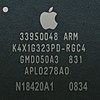
|
65 nm[3] | 36 mm2[3] | ARMv6 | 412–533 MHz single-core ARM11 | L1i: 16 KB L1d: 16 KB |
PowerVR MBX Lite | 32-bit Single-channel 133 MHz LPDDR (1066 MB/s) | September 2008 | |||
| APL0298 | 
|
65 nm[6] | 71.8 mm2[15] | ARMv7 | 600 MHz single-core Cortex-A8 | L1i: 32 KB L1d: 32 KB L2: 256 KB |
PowerVR SGX535 | 32-bit Single-channel 200 MHz LPDDR (1.6 GB/s) | June 2009 | |||
| APL2298 | 
|
45 nm[3] | 41.6 mm2[3] | ARMv7 | 600–800 MHz single-core Cortex-A8 | L1i: 32 KB L1d: 32 KB L2: 256 KB |
PowerVR SGX535 | 32-bit Single-channel 200 MHz LPDDR (1.6 GB/s) | September 2009 | |||
| A4 | APL0398 | 
|
45 nm[3][15] | 53.3 mm2[3][15] | ARMv7 | 0.8–1.0 GHz single-core Cortex-A8 | L1i: 32 KB L1d: 32 KB L2: 512 KB |
PowerVR SGX535[114] | 32-bit Dual-channel 200 MHz LPDDR (3.2 GB/s) | March 2010 | ||
| A5 | APL0498 | 
|
45 nm[34] | 122.2 mm2[34] | ARMv7 | 0.8–1.0 GHz dual-core Cortex-A9 | L1i: 32 KB L1d: 32 KB L2: 1 MB |
PowerVR SGX543MP2 (dual-core) @ 200 MHz (12.8 GFLOPS)[115] | 32-bit Dual-channel 400 MHz LPDDR2-800 (6.4 GB/s) | March 2011 | ||
| APL2498 | 
|
32 nm HKMG[35] | 69.6 mm2[35] | 0.8–1.0 GHz dual-core Cortex-A9 (one core locked in Apple TV) | L1i: 32 KB L1d: 32 KB L2: 1 MB |
PowerVR SGX543MP2 (dual-core) @ 200 MHz (12.8 GFLOPS)[115] | 32-bit Dual-channel 400 MHz LPDDR2-800 (6.4 GB/s) | March 2012 | ||||
| APL7498 | 
|
32 nm HKMG[41] | 37.8 mm2[41] | Single-core Cortex-A9 | L1i: 32 KB L1d: 32 KB L2: 1 MB |
PowerVR SGX543MP2 (dual-core) @ 200 MHz (12.8 GFLOPS)[115] | 32-bit Dual-channel 400 MHz LPDDR2-800 (6.4 GB/s) | March 2013 |
| |||
| A5X | APL5498 | 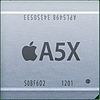
|
45 nm[43] | 165 mm2[43] | ARMv7 | 1.0 GHz dual-core Cortex-A9 | L1i: 32 KB L1d: 32 KB L2: 1 MB |
PowerVR SGX543MP4 (quad-core) @ 200 MHz (25 GFLOPS)[115] | 32-bit Quad-channel 400 MHz LPDDR2-800[116] (12.8 GB/s) | March 2012 | ||
| A6 | APL0598 | 
|
32 nm HKMG[53][117] | 96.71 mm2[53][117] | ARMv7s[118] | 1.3 GHz[119] dual-core Swift[50] | L1i: 32 KB L1d: 32 KB L2: 1 MB[120] |
PowerVR SGX543MP3 (triple-core) @ 266 MHz (25.5 GFLOPS)[52] | 32-bit Dual-channel 533 MHz LPDDR2-1066[121] (8.528 GB/s) | September 2012 | ||
| A6X | APL5598 | 
|
32 nm HKMG[56] | 123 mm2[56] | ARMv7s[118] | 1.4 GHz dual-core Swift[55] | L1i: 32 KB L1d: 32 KB L2: 1 MB |
PowerVR SGX554MP4 (quad-core) @ 266 MHz (68.1 GFLOPS)[55][122] | 32-bit Quad-channel 533 MHz LPDDR2-1066 (17.1 GB/s)[123] | October 2012 | ||
| A7 | APL0698 | 
|
28 nm HKMG[65] | 102 mm2[60] | ≈1 billion | ARMv8-A[61] | 1.3 GHz[58] dual-core Cyclone[61] | L1i: 64 KB L1d: 64 KB L2: 1 MB L3: 4 MB[61] (Inclusive)[124] |
PowerVR G6430 (quad-core) @ 450 MHz (115.2 GFLOPS)[63][122] | 64-bit Single-channel 800 MHz LPDDR3-1600[70] (12.8 GB/s)[125] | September 2013 | |
| APL5698 | 
|
28 nm HKMG[126] | 102 mm2[60][126] | ≈1 billion | 1.4 GHz[59] dual-core Cyclone[61] | L1i: 64 KB L1d: 64 KB L2: 1 MB L3: 4 MB[59] (Inclusive)[124] |
PowerVR G6430 (quad-core) @ 450 MHz (115.2 GFLOPS)[122] | 64-bit Single-channel 800 MHz LPDDR3-1600[70] (12.8 GB/s)[125] | October 2013 | |||
| A8 | APL1011 | 
|
20 nm (TSMC)[70] | 89 mm2[127] | ~2 billion | ARMv8-A[69] | 1.1–1.5 GHz dual-core Typhoon[69][128] | L1i: 64 KB L1d: 64 KB L2: 1 MB L3: 4 MB[69] (Inclusive)[124] |
PowerVR GX6450 (quad-core)[129][130] @ ~533 MHz (136.5 GFLOPS) | 64-bit Single-channel 800 MHz LPDDR3-1600[70] (12.8 GB/s)[125] | September 2014 | |
| A8X | APL1012 | 
|
20 nm (TSMC)[76][131] | 128 mm2[76] | ~3 billion | ARMv8-A | 1.5 GHz triple-core Typhoon[76][128] | L1i: 64 KB L1d: 64 KB L2: 2 MB L3: 4 MB[76] (Inclusive)[124] |
PowerVR GXA6850 (octa-core)[76][131] @ ~450 MHz (230.4 GFLOPS) | 64-bit Dual-channel 800 MHz LPDDR3-1600[76] (25.6 GB/s)[125] | October 2014 | |
| A9 | APL0898 | 
|
14 nm FinFET (Samsung)[132] | 96 mm2[133] | >2 billion | ARMv8-A | 1.85 GHz dual-core Twister[134][135] | L1i: 64 KB L1d: 64 KB L2: 3 MB L3: 4 MB (Victim)[124][136] |
PowerVR GT7600 (hexa-core)[137] @ ~600 MHz (230.4 GFLOPS) | 64-bit Single-channel 1600 MHz LPDDR4-3200[135][136] (25.6 GB/s)[135] | September 2015 | |
| APL1022 | 
|
16 nm FinFET (TSMC)[133] | 104.5 mm2[133] | |||||||||
| A9X | APL1021 | 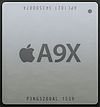
|
16 nm FinFET (TSMC)[138] | 143.9 mm2[138][82] | >3 billion | ARMv8-A | 2.16–2.26 GHz dual-core Twister[139][140] | L1i: 64 KB L1d: 64 KB L2: 3 MB L3: none[124][138] |
PowerVR 7XT Series (12-core)[138] @ ~533 MHz (409.3 GFLOPS) | 64-bit Dual-channel 1600 MHz LPDDR4-3200 (51.2 GB/s) | November 2015 | |
| A10 Fusion | APL1W24 | 
|
16 nm FinFET (TSMC)[141] | 125 mm2[141] | 3.3 billion | ARMv8-A | 2.34 GHz quad-core (2x Hurricane + 2x Zephyr)[142] | L1i: 64 KB L1d: 64 KB L2: 3 MB L3: 4 MB |
PowerVR GT7600 Plus (hexa-core)[143][144] @ >650 MHz (>250 GFLOPS) | 64-bit Single-channel 1600 MHz LPDDR4 (25.6 GB/s) | September 2016 | |
| A10X Fusion | APL1071[145] | 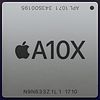
|
10 nm FinFET (TSMC)[82] | 96.4 mm2[82] | >4 billion | ARMv8-A | 2.36 GHz hexa-core (3x Hurricane + 3x Zephyr)[146] | L1i: 64 KB L1d: 64 KB L2: 8 MB L3: none[146] |
PowerVR GT7600 Plus (12-core)[81] | 64-bit Dual-channel 1600 MHz LPDDR4[146][145] (51.2 GB/s) | June 2017 | |
| A11 Bionic | APL1W72 | 
|
10 nm FinFET (TSMC) | 87.66 mm2[147] | 4.3 billion | ARMv8.2-A[148] | 2.39 GHz hexa-core (2x Monsoon + 4x Mistral) | L1i: 64 KB L1d: 64 KB L2: 8 MB L3: none[149] |
Apple Custom GPU (triple-core) | 64-bit Single-channel 2133 MHz LPDDR4X[150][151] (34.1 GB/s) | September 2017 | |
| A12 Bionic | APL1W81 | 
|
7 nm FinFET (TSMC) | 83.27 mm2[152] | 6.9 billion | ARMv8.3-A[153] | 2.49 GHz hexa-core (2x Vortex + 4x Tempest)[154] | L1i: 128 KB L1d: 128 KB L2: 8 MB L3: none[154] |
Apple Custom GPU (quad-core) | 64-bit Single-channel 2133 MHz LPDDR4X[155][156] (34.1 GB/s) | September 2018 | |
| A12X Bionic | APL1083 | 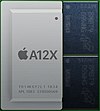
|
7 nm FinFET (TSMC) | ≈135 mm2[157] | 10 billion | ARMv8.3-A[153] | 2.49 GHz octa-core (4x Vortex + 4x Tempest) | L1i: 128 KB L1d: 128 KB L2: 8 MB L3: none[158] |
Apple Custom GPU (hepta-core) | 64-bit Dual-channel 2133 MHz LPDDR4X (68.2 GB/s) | October 2018 | |
| Name | Model no. | Image | Semiconductor technology | Die size | Transistor count | CPU ISA | CPU | CPU cache | GPU | Memory technology | Introduced | Utilizing devices |
S series list
| Name | Model no. | Image | Semiconductor technology | Die size | CPU ISA | CPU | CPU cache | GPU | Memory technology | Modem | Introduced | Utilizing devices |
|---|---|---|---|---|---|---|---|---|---|---|---|---|
| S1 | APL0778[159] | 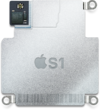
|
28 nm HKMG[160][161] | 32 mm2[160] | ARMv7k[161][162] | 520 MHz single-core Cortex-A7[161] | L1d: 32 KB[161] L2: 256 KB[161] |
PowerVR Series 5[161][163] | LPDDR3[164] | April 2015 | ||
| S1P | TBC | 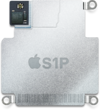
|
TBC | TBC | ARMv7k[165][166][167] | 520 MHz dual-core Cortex-A7 without GPS[165] | L1d: 64 KB[citation needed] L2: 1 MB[citation needed] |
PowerVR Series 6 'Rouge'[165] | LPDDR3 | September 2016 | ||
| S2 | TBC | 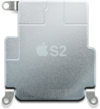
|
TBC | TBC | ARMv7k[165][166][167] | 520 MHz dual-core Cortex-A7 with GPS[165] | L1d: 64 KB[citation needed] L2: 1 MB[citation needed] |
PowerVR Series 6 'Rouge'[165] | LPDDR3 | September 2016 | ||
| S3 Non-LTE and LTE | TBC | 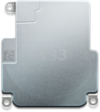
|
TBC | TBC | ARMv7k[168] | Dual-core | TBC | TBC | LPDDR4 | Qualcomm MDM9635M (Snapdragon X7 LTE) | September 2017 | |
| S4 Non-LTE and LTE | TBC | 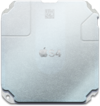
|
TBC | TBC | ARMv8-A ILP32[169][170] | Dual-core | TBC | TBC | TBC | TBC | September 2018 |
T series list
| Name | Model no. | Image | Semiconductor technology | Die size | CPU ISA | CPU | CPU cache | GPU | Memory technology | Introduced | Utilizing devices |
|---|---|---|---|---|---|---|---|---|---|---|---|
| T1 | APL1023[171] | 
|
ARMv7 | TBD | October 2016 | ||||||
| T2 | APL1027[172] | 
|
ARMv8-A | TBD | LPDDR4 | December 2017 |
W series list
| Name | Model no. | Image | Semiconductor technology | Die size | CPU ISA | CPU | CPU cache | Memory technology | Bluetooth | Introduced | Utilizing devices |
|---|---|---|---|---|---|---|---|---|---|---|---|
| W1 | 343S00130[173] 343S00131[173] |
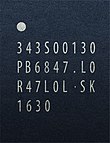
|
TBC | 14.3 mm2[173] | TBC | TBC | TBC | TBC | 4.2 | September 2016 | |
| W2 | 338S00348[174] | 
|
TBC | TBC | TBC | TBC | TBC | TBC | 4.2 | September 2017 | |
| W3 | TBC | TBC | TBC | TBC | TBC | TBC | TBC | TBC | 5.0 | September 2018 |
H series list
| Name | Model no. | Image | Bluetooth | Introduced | Utilizing devices |
|---|---|---|---|---|---|
| H1 | 343S00289[175] | TBC | 5.0 | March 2019 |
|
See also
- List of iOS devices
- Apple motion coprocessors
- List of Historical Samsung Systems on a Chip
- ARM Cortex-A9 MPCore
- PowerVR SGX GPUs were also used in the iPhone 3GS and the third-generation iPod touch
- PWRficient, a processor designed by P.A. Semi, a company Apple acquired to form an in-house custom chip design department
Similar platforms
- BCM2xxxx by Broadcom
- A31 by AllWinner
- Atom by Intel
- Exynos by Samsung
- i.MX by Freescale Semiconductor
- Jaguar and Puma by AMD
- Kirin by HiSilicon
- MTxxxx by MediaTek
- NovaThor by ST-Ericsson
- OMAP by Texas Instruments
- RK3xxx by Rockchip
- Snapdragon by Qualcomm
- Tegra by Nvidia
References
- ^ "The Most Important Apple Executive You've Never Heard Of". Bloomberg L.P. Retrieved June 18, 2016.
- ^ "iPhone 1st Generation Teardown". iFixit. June 29, 2007. Retrieved September 19, 2013.
- ^ a b c d e f g h i j k Choi, Young (May 10, 2010). "Analysis gives first look inside Apple's A4 processor". EETimes. Archived from the original on September 15, 2013. Retrieved September 15, 2013.
{{cite web}}: Unknown parameter|deadurl=ignored (|url-status=suggested) (help) - ^ a b "That iPod touch runs at 533 MHz". TechHive. November 25, 2008.
- ^ "iPod Touch 2nd Generation Teardown". iFixit. September 10, 2008. Retrieved September 19, 2013.
- ^ a b c Lal Shimpi, Anand (June 10, 2009). "The iPhone 3GS Hardware Exposed & Analyzed". AnandTech. Retrieved September 13, 2013.
- ^ Clark, Don (April 5, 2010). "Apple iPad Taps Familiar Component Suppliers - WSJ.com". Online.wsj.com. Retrieved April 15, 2010.
- ^ "iPad - It's thin, light, powerful, and revolutionary". Apple. Archived from the original on July 6, 2010. Retrieved July 7, 2010.
{{cite web}}: Unknown parameter|deadurl=ignored (|url-status=suggested) (help) - ^ a b "Apple Launches iPad" (Press release). Apple. January 27, 2010. Retrieved January 28, 2010.
- ^ "iPhone 4 design". Apple. July 6, 2010. Archived from the original on July 6, 2010.
{{cite web}}: Unknown parameter|dead-url=ignored (|url-status=suggested) (help) - ^ Vance, Ashlee (February 21, 2010). "For Chip Makers, the Next Battle Is in Smartphones". New York Times. Archived from the original on February 25, 2010. Retrieved February 25, 2010.
{{cite news}}: Unknown parameter|deadurl=ignored (|url-status=suggested) (help) - ^ "iPad — Technical specifications". Apple. Retrieved October 16, 2016.
- ^ Wiens, Kyle (April 5, 2010). "conclusion from both hard and software analysis it uses an ARM Cortex-A8 core". Ifixit.com. Archived from the original on April 18, 2010. Retrieved April 15, 2010.
{{cite web}}: Unknown parameter|deadurl=ignored (|url-status=suggested) (help) - ^ Melanson, Donald (February 23, 2010). "iPad confirmed to use PowerVR SGX graphics". Engadget.
- ^ a b c d "Chipworks Confirms Apple A4 iPad chip is fabbed by Samsung in their 45-nm process". Chipworks. April 15, 2010. Archived from the original on September 21, 2010.
{{cite web}}: Unknown parameter|deadurl=ignored (|url-status=suggested) (help) - ^ Stokes, Jon (April 28, 2010). "Apple purchase of Intrinsity confirmed". Ars Technica. Archived from the original on April 28, 2010. Retrieved April 28, 2010.
{{cite web}}: Unknown parameter|deadurl=ignored (|url-status=suggested) (help) - ^ Merritt, Rick. "Samsung, Intrinsity pump ARM to GHz rate". EETimes.com. Retrieved April 23, 2010.
- ^ Keizer, Gregg (April 6, 2010). "Apple iPad smokes past the iPhone 3GS in speed". PC World. Archived from the original on April 20, 2010. Retrieved April 11, 2010.
{{cite web}}: Unknown parameter|deadurl=ignored (|url-status=suggested) (help) - ^ Boldt, Paul; Scansen, Don; Whibley, Tim (June 16, 2010). "Apple's A4 dissected, discussed...and tantalizing". EETimes.com. Retrieved July 7, 2010.
- ^ "Microsoft PowerPoint - Apple A4 vs SEC S5PC110A01" (PDF). Archived from the original (PDF) on July 4, 2010. Retrieved July 7, 2010.
{{cite web}}: Unknown parameter|deadurl=ignored (|url-status=suggested) (help) - ^ "Apple iPad 2 GPU Performance Explored: PowerVR SGX543MP2 Benchmarked - AnandTech :: Your Source for Hardware Analysis and News". AnandTech. Archived from the original on March 18, 2011. Retrieved March 15, 2011.
{{cite web}}: Unknown parameter|deadurl=ignored (|url-status=suggested) (help) - ^ "Teardown of Apple's 4th-gen iPod touch finds 256MB of RAM". Appleinsider.com. September 8, 2010. Archived from the original on September 11, 2010. Retrieved September 10, 2010.
{{cite web}}: Unknown parameter|deadurl=ignored (|url-status=suggested) (help) - ^ "Apple TV 2nd Generation Teardown". iFixit. September 30, 2010. Archived from the original on January 2, 2011. Retrieved January 4, 2011.
{{cite web}}: Unknown parameter|deadurl=ignored (|url-status=suggested) (help) - ^ "Apple reveals iPhone 4 has 512MB RAM, doubling iPad - report". AppleInsider. June 17, 2010. Archived from the original on July 4, 2010. Retrieved July 7, 2010.
{{cite news}}: Unknown parameter|deadurl=ignored (|url-status=suggested) (help) - ^ "A Peek Inside Apple's A4 Processor". iFixit. April 5, 2010.
- ^ Greenberg, Marc (April 9, 2010). "Apple iPad: no LPDDR2?". Denali.
- ^ Merritt, Rick (April 9, 2010). "iPad equipped to deliver richer graphics". EE Times Asia. Archived from the original on September 27, 2011. Retrieved April 14, 2010.
{{cite news}}: Unknown parameter|deadurl=ignored (|url-status=suggested) (help) - ^ "Updated: Samsung fabs Apple A5 processor". EETimes.com. March 12, 2011. Archived from the original on May 9, 2013. Retrieved March 15, 2011.
{{cite web}}: Unknown parameter|deadurl=ignored (|url-status=suggested) (help) - ^ "Apple Announces iPad 2 with New Design, Faster A5 Processor".
- ^ "Apple iPad 2 feature page". Apple.com. Archived from the original on March 16, 2011. Retrieved March 15, 2011.
{{cite web}}: Unknown parameter|deadurl=ignored (|url-status=suggested) (help) - ^ a b "Apple iPad 2 Preview - AnandTech :: Your Source for Hardware Analysis and News". AnandTech. Retrieved March 15, 2011.
- ^ "iPad 2 - Technical Specifications". Apple. Retrieved October 16, 2016.
- ^ "Inside Apple's iPad 2 A5: fast LPDDR2 RAM, costs 66% more than Tegra 2". AppleInsider. Retrieved March 15, 2011.
- ^ a b c "A First Look at Apple's A5 Processor". Chipworks. March 12, 2011. Retrieved September 15, 2013.
- ^ a b c "Update – 32-nm Apple A5 in the Apple TV 3 – and an iPad 2!". Chipworks. April 11, 2012. Retrieved September 15, 2013.
- ^ "Single-core A5 CPU in new 1080p Apple TV doubles RAM to 512MB". AppleInsider.
- ^ "Update – 32-nm Apple A5 in the Apple TV 3 – and an iPad 2!". ChipWorks. April 11, 2012. Retrieved April 12, 2012.
- ^ "The iPad 2,4 Review: 32nm Brings Better Battery Life". AnandTech. Retrieved November 1, 2012.
- ^ "A5 Chip in Tweaked Apple TV Still Manufactured by Samsung at 32nm".
- ^ "Tweaked Apple TV Contains Die-Shrunk A5 Chip, Not A5X".
- ^ a b c "Apple's TV surprise – a new A5 chip!". Chipworks. March 12, 2013. Retrieved September 15, 2013.
- ^ "Apple Launches New iPad". Apple. March 7, 2012. Retrieved September 17, 2013.
- ^ a b c "The Apple A5X versus the A5 and A4 – Big Is Beautiful". Chipworks. March 19, 2012. Retrieved September 15, 2013.
- ^ "Apple A5X Die Size Measured: 162.94mm^2, Samsung 45nm LP Confirmed". AnandTech. Retrieved November 1, 2012.
- ^ "The Frequency of Apple A5X in the New iPad Confirmed: Still Running at 1GHz". AnandTech. Retrieved November 1, 2012.
- ^ "iFixit teardown of the 3rd generation iPad". iFixit.
- ^ Apple Introduces iPhone 5, Apple.com, September 12, 2012, retrieved September 20, 2012
- ^ "Apple: A6 chip in iPhone 5 has 2x CPU power, 2x graphics performance, yet consumes less energy".
- ^ Apple's A6 CPU actually clocked at around 1.3 GHz, per new Geekbench report, Engadget, September 26, 2012, retrieved September 26, 2012
- ^ a b c Lal Shimpi, Anand (September 15, 2012). "The iPhone 5's A6 SoC: Not A15 or A9, a Custom Apple Core Instead". AnandTech. Retrieved September 15, 2012.
- ^ Lal Shimpi, Anand; Klug, Brian; Gowri, Vivek (October 16, 2012). "The iPhone 5 Review - Decoding Swift". AnandTech. Retrieved October 17, 2012.
- ^ a b "Apple A6 Die Revealed: 3-core GPU, <100mm^2". AnandTech. September 21, 2012. Retrieved September 22, 2012.
- ^ a b c "Apple iPhone 5 – the A6 Application Processor". Chipworks. September 21, 2012. Archived from the original on September 22, 2013. Retrieved September 15, 2013.
{{cite web}}: Unknown parameter|deadurl=ignored (|url-status=suggested) (help) - ^ "Apple Introduces iPad mini". Apple. October 23, 2012. Retrieved September 16, 2013.
- ^ a b c d Lal Shimpi, Anand (November 2, 2012). "iPad 4 GPU Performance Analyzed: PowerVR SGX 554MP4 Under the Hood". AnandTech. Retrieved September 16, 2013.
- ^ a b c d "Inside the Apple iPad 4 – A6X a very new beast!". Chipworks. November 1, 2012. Retrieved September 15, 2013.
- ^ "Apple Announces iPhone 5s—The Most Forward-Thinking Smartphone in the World". Apple. September 10, 2013. Retrieved September 13, 2013.
- ^ a b c d Lal Shimpi, Anand (September 17, 2013). "The iPhone 5s Review: A7 SoC Explained". AnandTech. Retrieved September 18, 2013.
- ^ a b c Lai Shimpi, Anand (October 29, 2013). "The iPad Air Review: iPhone to iPad: CPU Changes". AnandTech. Retrieved October 30, 2013.
- ^ a b c d Lal Shimpi, Anand (September 17, 2013). "The iPhone 5s Review: The Move to 64-bit". AnandTech. Retrieved September 18, 2013.
- ^ a b c d e f Lal Shimpi, Anand (September 17, 2013). "The iPhone 5s Review: After Swift Comes Cyclone". AnandTech. Retrieved September 18, 2013.
- ^ Lattner, Chris (September 10, 2013). "[LLVMdev] A7 processor support?". llvm-dev (Mailing list). Retrieved July 9, 2017.
- ^ a b Lal Shimpi, Anand (September 17, 2013). "The iPhone 5s Review: GPU Architecture". AnandTech. Retrieved September 18, 2013.
- ^ Cunningham, Andrew (September 10, 2013). "Apple unveils 64-bit iPhone 5S with fingerprint scanner, $199 for 16GB". Ars Technica. Retrieved September 12, 2013.
- ^ a b Tanner, Jason; Morrison, Jim; James, Dick; Fontaine, Ray; Gamache, Phil (September 20, 2013). "Inside the iPhone 5s". Chipworks. Archived from the original on August 3, 2014. Retrieved September 20, 2013.
- ^ "Apple Announces iPhone 6 & iPhone 6 Plus—The Biggest Advancements in iPhone History" (Press release). Apple. September 9, 2014. Retrieved September 9, 2014.
- ^ Savov, Vlad (September 9, 2014). "iPhone 6 and iPhone 6 Plus have a new faster A8 processor". The Verge. Vox Media. Retrieved September 9, 2014.
- ^ "HomePod Teardown". iFixit. February 12, 2018. Retrieved February 13, 2018.
- ^ a b c d e "The iPhone 6 Review: A8's CPU: What Comes After Cyclone?". AnandTech. September 30, 2014. Retrieved September 30, 2014.
- ^ a b c d e f "The iPhone 6 Review: A8: Apple's First 20nm SoC". AnandTech. September 30, 2014. Retrieved September 30, 2014.
- ^ Smith, Ryan (September 9, 2014). "Apple Announces A8 SoC". AnandTech. Retrieved September 9, 2014.
- ^ "Inside the iPhone 6 and iPhone 6 Plus". Chipworks. September 19, 2014. Retrieved September 20, 2014.
- ^ Anthony, Sebastian. "Apple's A8 SoC analyzed: The iPhone 6 chip is a 2-billion-transistor 20nm monster". www.extremetech.com. ExtremeTech. Retrieved September 10, 2014.
- ^ a b "Apple Introduces iPad Air 2—The Thinnest, Most Powerful iPad Ever" (Press release). Apple. October 16, 2014. Retrieved October 16, 2014.
- ^ "iPad Air 2 - Performance". Apple. October 16, 2014. Retrieved October 16, 2014.
- ^ a b c d e f g h "Apple A8X's GPU - GXA6850, Even Better Than I Thought". Anandtech. November 11, 2014. Retrieved November 12, 2014.
- ^ a b "Apple Introduces iPhone 6s & iPhone 6s Plus" (Press release). Apple. September 9, 2015. Retrieved September 9, 2015.
- ^ "Apple Introduces iPad Pro Featuring Epic 12.9-inch Retina Display" (Press release). Apple. September 9, 2015. Retrieved September 9, 2015.
- ^ "Apple's new iPad Pro is an expansive 12.9 inches, available in November". Ars Technica. Retrieved September 9, 2015.
- ^ "Apple Introduces iPhone 7 & iPhone 7 Plus —The Best, Most Advanced iPhone Ever" (Press release). Apple Inc. September 7, 2016. Retrieved September 16, 2016.
- ^ a b c "iPad Pro, in 10.5-inch and 12.9-inch models, introduces the world's most advanced display and breakthrough performance" (Press release). Apple Inc. June 5, 2017. Retrieved June 5, 2017.
- ^ a b c d Wei, Andy (June 29, 2017). "10 nm Process Rollout Marching Right Along". TechInsights. Archived from the original on August 3, 2017. Retrieved June 30, 2017.
{{cite web}}: Unknown parameter|dead-url=ignored (|url-status=suggested) (help) - ^ a b c "iPhone 8 and iPhone 8 Plus: A new generation of iPhone" (Press release). Apple Inc. September 12, 2017. Retrieved September 12, 2017.
- ^ "iPhone 8:A11 Bionic". Apple Inc. September 12, 2017. Retrieved September 12, 2017.
- ^ "A12 Bionic". Apple Inc. September 12, 2018. Retrieved November 22, 2018.
- ^ a b Summers, Nick (September 12, 2018). "Apple's A12 Bionic is the first 7-nanometer smartphone chip". Engadget. Retrieved September 12, 2018.
- ^ "iPhone Xs and iPhone Xs Max bring the best and biggest displays to iPhone" (Press release). Apple Inc. September 12, 2018. Retrieved September 12, 2018.
- ^ Smith, Ryan (September 12, 2018). "Apple Announces the 2018 iPhones: iPhone XS, iPhone XS Max, & iPhone XR". AnandTech. Retrieved September 12, 2018.
- ^ https://www.apple.com/newsroom/2018/10/new-ipad-pro-with-all-screen-design-is-most-advanced-powerful-ipad-ever/
- ^ Kleinman, Jacob (September 9, 2014). "Apple Watch Uses a New S1 Chip & Heart Rate Monitor".
- ^ a b c d "Apple Watch Series 3 brings built-in cellular, powerful new health and fitness enhancements" (Press release). Apple Inc. September 12, 2017.
- ^ Smith, Ryan (October 27, 2016). "Apple Announces 4th Generation MacBook Pro Family: Thinner, Lighter, with Thunderbolt 3 & "Touchbar"". Anandtech. Retrieved October 27, 2016.
- ^ a b c Cunningham, Andrew (October 28, 2016). "15 hours with the 13" MacBook Pro, and how Apple's T1 bridges ARM and Intel". Ars Technica. Retrieved December 4, 2018.
- ^ Parrish, Kevin (July 24, 2018). "Apple's T2 chip may be causing issues in iMac Pro and 2018 MacBook Pros". DigitalTrends. Archived from the original on September 18, 2018. Retrieved January 22, 2019.
Of all the error messages uploaded to these threads, there is one detail they seem to share: Bridge OS. This is an embedded operating system used by Apple's stand-alone T2 security chip, which provides the iMac Pro with a secure boot, encrypted storage, live "Hey Siri" commands, and so on.
- ^ Stroughton-Smith, Steven [@stroughtonsmith] (October 27, 2016). "And there you have it. Apple's T1 chip runs an iOS (technically watchOS for armv7k) variant" (Tweet) – via Twitter.
- ^ "iMac Pro Features Apple's Custom T2 Chip With Secure Boot Capabilities". MacRumors. December 14, 2017.
- ^ Evans, Jonny. "The MacBook Pro's T2 chip boosts enterprise security". ComputerWorld.
- ^ "The T2 chip makes the iMac Pro the start of a Mac revolution". Macworld.
- ^ "iMac Pro debuts custom Apple T2 chip to handle secure boot, password encryption, more". AppleInsider. December 12, 2017. Retrieved December 14, 2017.
- ^ "Everything you need to know about Apple's T2 chip in the 2018 MacBook Pro". AppleInsider. August 8, 2018.
- ^ Rossignol, Joe (July 12, 2018). "Apple Launches 2018 MacBook Pros: 8th Gen Core, Up to 32GB of RAM, Third-Gen Keyboard, Quad-Core on 13-Inch and More". MacRumors. Retrieved July 12, 2018.
- ^ "Apple updates MacBook Pro with faster performance and new features for pros". Apple Inc.
- ^ Broussard, Mitchel (October 30, 2018). "Apple Announces New MacBook Air With 13-Inch Retina Display and Touch ID". MacRumors. Retrieved October 30, 2018.
- ^ Hardwick, Tim (October 30, 2018). "Apple Announces New Space Gray Mac mini With 4-Core or 6-Core Intel Processor and Up to 64GB RAM, Starting at $799". MacRumors. Retrieved October 30, 2018.
- ^ Tilley, Aaron. "Apple Creates Its First Wireless Chip For New Wireless Headphones, AirPods". Forbes.
- ^ "Apple Announces New Line of Beats Headphones With W1 Wireless Chip". MacRumors.
- ^ "Apple's AirPods do use Bluetooth and they don't require an iPhone 7". Recode.
- ^ "AirPods". Apple Inc.
- ^ "Apple Watch Series 4". Apple Inc. Retrieved September 13, 2018.
- ^ "Apple Watch - Compare Models". Apple Inc. Retrieved September 13, 2018.
- ^ Mayo, Benjamin. "New Apple AirPods now available: H1 chip, wireless charging case, hands-free Hey Siri". 9to5Mac. Retrieved March 20, 2019.
- ^ "AirPods, the world's most popular wireless headphones, are getting even better". Apple Newsroom. Apple Inc. Retrieved March 21, 2019.
- ^ Lal Shimpi, Anand; Klug, Brian (October 31, 2011). "Apple iPhone 4S: Thoroughly Reviewed - The Memory Interface". AnandTech. Retrieved September 15, 2013.
- ^ Wiens, Kyle (April 5, 2010). "conclusion from both hard and software analysis it uses an ARM Cortex-A8 core". Ifixit.com. Archived from the original on April 18, 2010. Retrieved April 15, 2010.
{{cite web}}: Unknown parameter|deadurl=ignored (|url-status=suggested) (help) - ^ a b c d Lal Shimpi, Anand (September 2012). "The iPhone 5 Performance Preview". AnandTech. Retrieved October 24, 2012.
- ^ "The Apple iPad Review (2012)". AnandTech. Retrieved November 1, 2012.
- ^ a b "Apple A6 Teardown". IFixit. September 25, 2012.
- ^ a b "Xcode 6 drops armv7s". Cocoanetics. October 10, 2014.
- ^ "The iPhone 5 Performance Preview". AnandTech. Retrieved November 1, 2012.
- ^ "iPhone 5 Benchmarks Appear in Geekbench Showing a Dual Core, 1GHz A6 CPU".
- ^ Shimpi, Anand Lal; Klug, Brian (September 15, 2012). "iPhone 5 Memory Size and Speed Revealed: 1 GB LPDDR2-1066". AnandTech. Retrieved September 16, 2012.
- ^ a b c Lai Shimpi, Anand (October 29, 2013). "The iPad Air Review: GPU Performance". AnandTech. Retrieved October 30, 2013.
- ^ "iPad 4 (Late 2012) Review". AnandTech. Retrieved July 10, 2013.
- ^ a b c d e f "Correcting Apple's A9 SoC L3 Cache Size: A 4MB Victim Cache". AnandTech. November 30, 2015. Retrieved December 1, 2015.
- ^ a b c d "The Apple iPad Air 2 Review". AnandTech. Retrieved November 12, 2014.
- ^ a b "Inside the iPad Air". Chipworks. November 1, 2013. Archived from the original on May 8, 2015. Retrieved November 12, 2013.
{{cite web}}: Unknown parameter|dead-url=ignored (|url-status=suggested) (help) - ^ "Apple's A8 SoC analyzed". ExtremeTech. September 10, 2014.
- ^ a b Chester, Brandon (July 15, 2015). "Apple Refreshes The iPod Touch With A8 SoC And New Cameras". Retrieved September 11, 2015.
- ^ "Chipworks Disassembles Apple's A8 SoC: GX6450, 4MB L3 Cache & More". AnandTech. September 23, 2014.
- ^ "Imagination PowerVR GX6450". NOTEBOOKCHECK. September 23, 2014.
- ^ a b "Imagination PowerVR GXA6850 - NotebookCheck.net Tech". NotebookCheck.net. November 26, 2014. Retrieved November 26, 2014.
- ^ Ho, Joshua (September 9, 2015). "Apple Announces the iPhone 6s and iPhone 6s Plus". Retrieved September 10, 2015.
- ^ a b c "Apple's A9 SoC Is Dual Sourced From Samsung & TSMC". Anandtech. September 28, 2015. Retrieved September 29, 2015.
- ^ "iPhone 6s customer receives her device early, benchmarks show a marked increase in power". iDownloadBlog. September 21, 2015. Retrieved September 25, 2015.
- ^ a b c "A9's CPU: Twister - The Apple iPhone 6s and iPhone 6s Plus Review". AnandTech. November 2, 2015. Retrieved November 4, 2015.
- ^ a b "Inside the iPhone 6s". Chipworks. September 25, 2015. Retrieved September 26, 2015.
- ^ "A9's GPU: Imagination PowerVR GT7600 - The Apple iPhone 6s and iPhone 6s Plus Review". AnandTech. November 2, 2015. Retrieved November 4, 2015.
- ^ a b c d "More on Apple's A9X SoC: 147mm2@TSMC, 12 GPU Cores, No L3 Cache". AnandTech. November 30, 2015. Retrieved December 1, 2015.
- ^ "The A9X SoC & More To Come - The iPad Pro Preview: Taking Notes With iPad Pro". AnandTech. November 11, 2015. Retrieved November 11, 2015.
- ^ "iPad Pro review: Mac-like speed with all the virtues and restrictions of iOS". AnandTech. November 11, 2015. Retrieved November 11, 2015.
- ^ a b techinsights.com. "Apple iPhone 7 Teardown". www.chipworks.com.
- ^ "Kernel Changes for Objective-C". developer.apple.com.
- ^ "iPhone 7 GPU breakdown". Wccftech. December 2016.
- ^ "Mysteries of Apple A10 GPU". PC World. December 2016.
- ^ a b "iPad Pro 10.5" Teardown". iFixit. June 13, 2017. Retrieved June 14, 2017.
- ^ a b c Smith, Ryan (June 29, 2017). "TechInsights Confirms Apple's A10X SoC Is TSMC 10nm FF; 96.4mm2 Die Size". AnandTech. Retrieved June 30, 2017.
- ^ "Apple iPhone 8 Plus Teardown". TechInsights. September 27, 2017. Retrieved September 28, 2017.
- ^ "Apple A11 New Instruction Set Extensions" (PDF). Apple Inc. June 8, 2018.
- ^ "Measured and Estimated Cache Sizes". AnandTech. October 5, 2018.
- ^ techinsights.com. "Apple iPhone 8 Plus Teardown". techinsights.com. Retrieved October 9, 2018.
- ^ "MT53D384M64D4NY-046 XT:D Micron Technology Inc. | Integrated Circuits (ICs) | DigiKey". www.digikey.com. Retrieved October 9, 2018.
- ^ "Apple iPhone Xs Max Teardown". TechInsights. September 21, 2018. Retrieved September 21, 2018.
- ^ a b "Apple A12 Pointer Authentication Codes". Jonathan Levin, @Morpheus. September 12, 2018.
- ^ a b https://www.gsmarena.com/new_iphone_xs_xs_max_and_xr_benchmarked_ram_revealed-news-33246.php#image0
- ^ techinsights.com. "Apple iPhone XS Teardown". www.techinsights.com. Retrieved October 9, 2018.
- ^ "MT53D512M64D4SB-046 XT:E Micron | Mouser". Mouser Electronics. Retrieved October 9, 2018.
- ^ "The Packaging of Apple's A12X is… Weird". Dick James of Chipworks. January 16, 2019.
- ^ https://browser.geekbench.com/v4/cpu/11836094
- ^ "Teardown shows Apple Watch S1 chip has custom CPU, 512MB RAM, 8GB storage". AppleInsider. Retrieved April 30, 2015.
- ^ a b "Inside the Apple Watch: Technical Teardown". Chipworks. April 24, 2015.
{{cite web}}: Unknown parameter|authors=ignored (help) - ^ a b c d e f Ho, Joshua; Chester, Brandon (July 20, 2015). "The Apple Watch Review: Apple S1 Analysis". AnandTech. Retrieved July 20, 2015.
- ^ "Steve Troughton-Smith on Twitter".
- ^ "Apple Watch runs 'most' of iOS 8.2, may use A5-equivalent processor". AppleInsider. Retrieved April 25, 2015.
- ^ Ho, Joshua; Chester, Brandon (July 20, 2015). "The Apple Watch Review". AnandTech. Retrieved July 20, 2015.
- ^ a b c d e f Chester, Brandon (December 20, 2016). "The Apple Watch Series 2 Review: Building Towards Maturity". AnandTech. Retrieved February 10, 2018.
- ^ a b "We Just Took Apart the Apple Watch Series 1—Here's What We Found Out".
- ^ a b "Apple introduces Apple Watch Series 2".
- ^ "Apple CPU Architectures". Jonathan Levin, @Morpheus. September 20, 2018.
- ^ "ILP32 for AArch64 Whitepaper". ARM Limited. June 9, 2015.
- ^ "Apple devices in 2018". woachk, security researcher. October 6, 2018.
- ^ "MacBook Pro 13" Touch Bar Teardown". iFixit. Retrieved November 17, 2016.
- ^ "iMac Pro Teardown". January 2, 2018.
- ^ a b c techinsights.com. "Apple W1 343S00131 Bluetooth Module". w2.techinsights.com. Retrieved February 17, 2017.
- ^ techinsights.com. "Apple Watch Series 3 Teardown". techinsights.com.
- ^ "AirPods 2 Teardown". iFixit. March 28, 2019. Retrieved April 4, 2019.
Further reading
- Gurman, Mark (January 29, 2018). "How Apple Built a Chip Powerhouse to Threaten Qualcomm and Intel". Bloomberg Businessweek.
